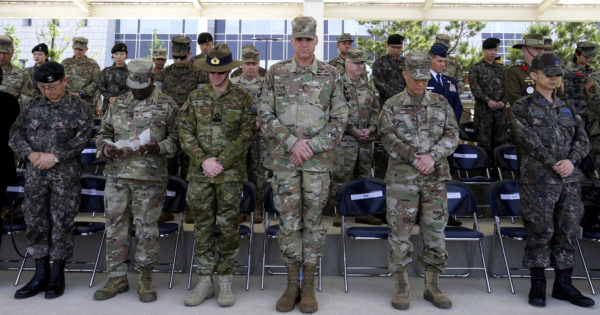Reports from a questionable thinktank claim North Korea nuclear weapons development continues as the U.S. commits to an indefinite troop presence and new missile defense systems.
SEOUL, SOUTH KOREA – After the recent Singapore summit kick-started peace talks aimed at ending hostilities on the Korean peninsula, the tone among many Koreans, Americans and other observers was optimistic, as a peaceful resolution to the conflict seemed within reach. Yet, while peace on the Korean peninsula is something most continue to hope for, recent actions taken by the Pentagon suggest that the U.S. military-industrial complex is banking on the talks to either fail or hostilities in the region to again break out in the not-so-distant future.
On Wednesday, for example, government officials announced that the Pentagon was planning to spend around $1 billion to install a missile defense radar on the Hawaiian island of Oahu in order to track ballistic missile threats coming from North Korea or elsewhere. Though the radar, aimed at countering “evolving missile threats in the Pacific Region,” was mandated by the 2017 National Defense Authorization Act – a law signed by Barack Obama in 2016 — the fact that the Pentagon mentioned North Korean missiles explicitly in connection with the radar, while peace talks are ongoing, is both significant and concerning.
Furthermore, the same day that news of the Pentagon’s plan to build the radar was published, U.S.-based website 38 North released satellite imagery that purported to show that North Korea was upgrading infrastructure at the Yongbyon Nuclear Scientific Research Center, which the site claimed is used in the production of weapons-grade fissile material. Though the report stated that “continued work at the Yongbyon facility should not be seen as having any relationship to North Korea’s pledge to denuclearize,” U.S. experts asserted that it meant that North Korea was seeking to “exploit” diplomacy.
Commercial satellite imagery from June 21 indicates that improvements to the infrastructure at North Korea’s Yongbyon Nuclear Scientific Research Center are continuing at a rapid pace. https://t.co/by1wVsojAZ
— 38 North (@38NorthNK) June 26, 2018
It is also worth noting that 38 North itself is managed by former CIA and State Department official Joel Wit and is currently housed in the Stimson Center — home to the Stimson Center think tank, which is well-connected to defense contractors such as Boeing and the hawkish RAND corporation.
Given the Pentagon’s mention of North Korean missiles as well as the Trump administration’s failure to postpone or cancel the Oahu project, the possibility is raised that aggression between North Korea and the U.S. is expected in the near future and/or that the radar is intended for use against a larger country in the Pacific region, such as China – an ally of North Korea.
Indeed, some experts have long maintained that China – not North Korea – is the real target of the U.S.’ military build-up in the Pacific and that U.S. threats and military buildup targeting North Korea have actually been aimed at curbing Beijing’s military aspirations in the Pacific region.
Korean peace bad for U.S. weapons-makers and economy?
However, another indication that the Pentagon was anticipating a future conflict with North Korea came from Secretary of Defense James Mattis on Thursday, when he vowed that the 32,000 U.S. soldiers stationed in South Korea will remain in the country indefinitely as part of the U.S.’ “ironclad” commitment to South Korea’s defense. Mattis’ statements directly contradict prior statements made by President Trump on June 12, when the President stated that he wanted “to get our soldiers out” of South Korea. Mattis did, however, support Trump’s decision to pause large-scale war games between the U.S. and South Korean militaries during Korean peace negotiations.
Considering that Mattis’s statements and the Pentagon’s plan to build new missile radar could potentially throw a wrench into the Korea peace talks, it is possible that the growing rift between Mattis and the President could deepen. However, Mattis is largely representing the interests of the U.S. defense industry and the U.S. military as a whole — as peace on the Korean peninsula would mean both a loss of revenue for weapons manufacturers and a loss of regional influence for the U.S. empire, something much of the Washington power structure seeks to avoid even at the risk of upending peace negotiations. Indeed, recent warnings that peace in Korea could trigger an “economic collapse” in the United States make this clear.
Source: www.mintpressnews.com




